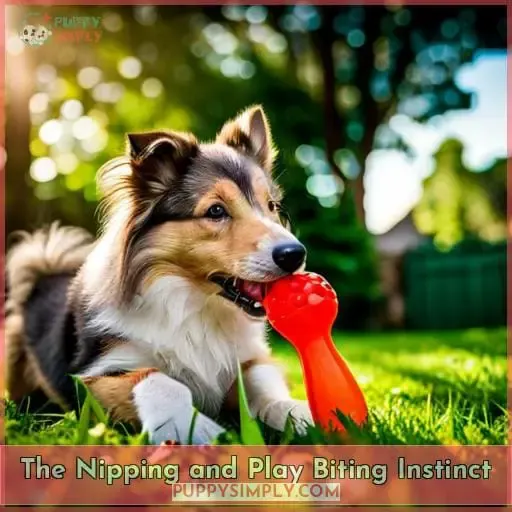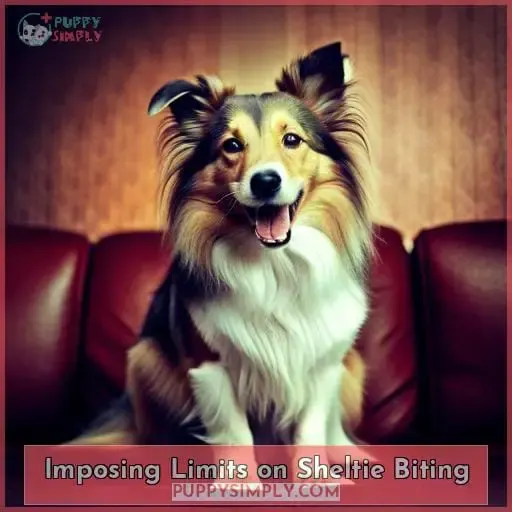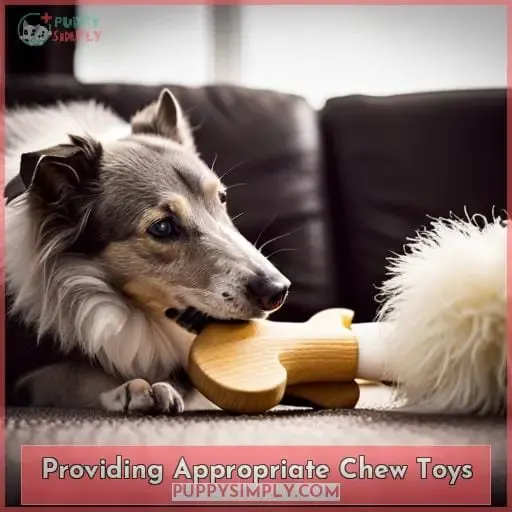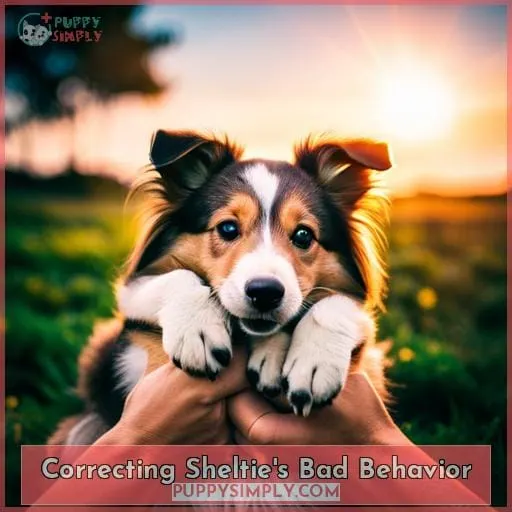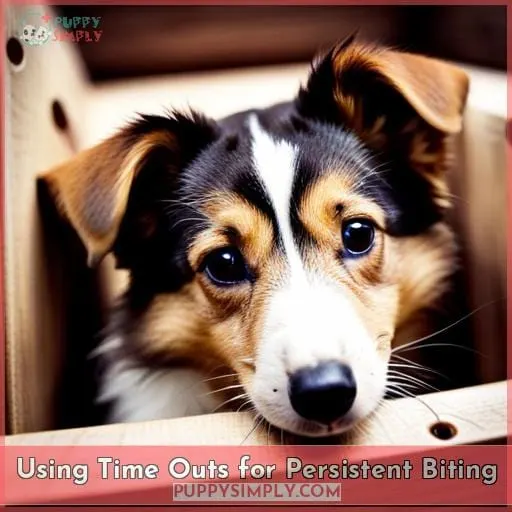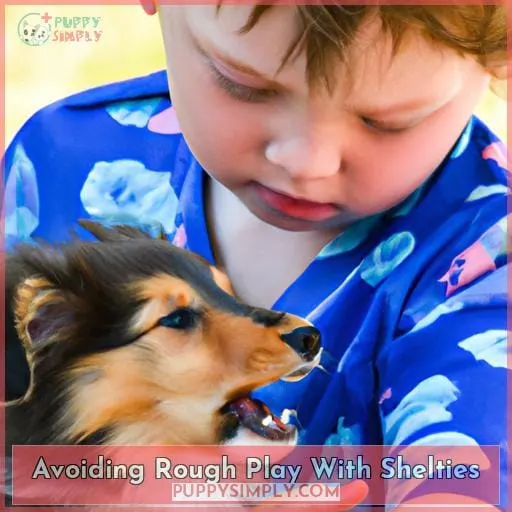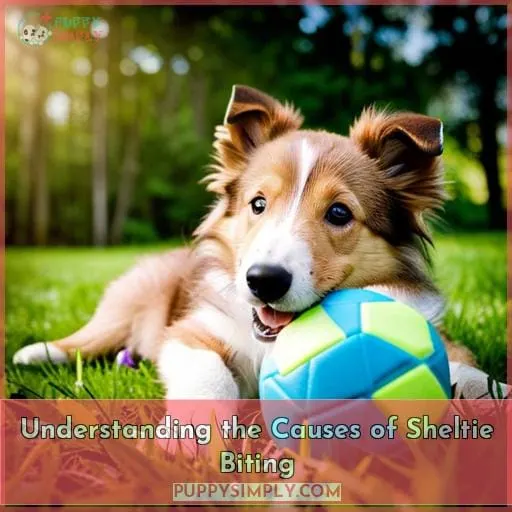This site is supported by our readers. We may earn a commission, at no cost to you, if you purchase through links.
 Imagine a world where your Sheltie no longer bites or nips at you. A world where you can enjoy peaceful walks and playtime without the fear of sharp teeth.
Imagine a world where your Sheltie no longer bites or nips at you. A world where you can enjoy peaceful walks and playtime without the fear of sharp teeth.
In this article, we will explore when Shelties stop biting and how to effectively curb their nipping behavior. With proven techniques and expert guidance, you’ll gain the knowledge and tools needed to create a harmonious bond with your beloved Shetland Sheepdog.
So let’s get started on this journey towards bite-free bliss!
Table Of Contents
- Key Takeaways
- The Nipping and Play Biting Instinct
- Refining Bite Inhibition in Shelties
- Setting the Limit on Sheltie Biting
- Imposing Limits on Sheltie Biting
- Providing Appropriate Chew Toys
- Correcting Sheltie’s Bad Behavior
- Using Time Outs for Persistent Biting
- Avoiding Rough Play With Shelties
- Understanding the Causes of Sheltie Biting
- Frequently Asked Questions (FAQs)
- How long does it typically take for Shelties to stop biting?
- Are there any specific techniques or methods that work best for stopping biting in Shelties?
- What are some signs that biting in Shelties may be excessive or problematic?
- Can providing chew toys alone effectively stop biting behavior in Shelties?
- Are there any specific breeds or factors that may contribute to more persistent biting behavior in Shelties?
- Conclusion
Key Takeaways
- Sheltie puppies naturally nip during play, and it is part of bite inhibition learning.
- Early socialization and consistent reinforcement are crucial in setting play boundaries and refining bite inhibition.
- Teething stages can intensify nipping tendencies, but providing appropriate chew toys and redirecting attention can help alleviate this behavior.
- Correcting bad behavior promptly using positive reinforcement and avoiding physical force can help in stopping biting habits in Shelties.
The Nipping and Play Biting Instinct
One natural behavior you’ll notice in Sheltie puppies is their instinct to nip and bite during play. This behavior is a normal part of their development as they explore the world using their mouths.
It’s important to understand that biting is a way for young pups to learn bite inhibition, which involves controlling the pressure of their bites. Early socialization plays a crucial role in teaching them appropriate communication cues and setting boundaries for play biting.
Additionally, it’s essential to provide teething toys during the puppy’s teething stages to redirect their behavior towards more suitable items.
By implementing positive reinforcement techniques and consistent redirection, you can help your Sheltie puppy develop good bite inhibition habits while ensuring safe and enjoyable playtime experiences.
Refining Bite Inhibition in Shelties
To refine bite inhibition in Shelties, you need to consistently reinforce appropriate limits on their biting behavior. Behavioral conditioning and social learning play a crucial role in teaching your Sheltie how to control their biting impulses.
It’s important to understand that teething challenges can contribute to excessive nipping and biting during certain developmental milestones. By providing appropriate chew toys and redirecting attention towards them, you can help your Sheltie develop better communication skills and learn what’s acceptable to bite.
Correcting bad behavior promptly with a sharp No! or negative statement, followed by praise when they redirect their attention appropriately, reinforces the desired behavior.
Implement time-outs using a crate or small room if persistent nipping occurs, gradually reintroducing play while toning down the excitement level.
Setting the Limit on Sheltie Biting
To set the limit on Sheltie biting, establish clear boundaries and guidelines for acceptable mouthing behavior.
Limit enforcement plays a crucial role in shaping your Sheltie puppy’s behavior.
Begin by implementing behavioral conditioning techniques that promote positive reinforcement and interactive redirection.
Consistent correction is key when dealing with their biting tendencies.
When your Sheltie starts to nip or bite, redirect their attention towards appropriate chew toys or bones to reinforce positive chewing behavior.
Avoid using physical force as it may escalate aggression instead of curbing the problem.
By consistently enforcing limitations and providing outlets for their chewing needs, you can effectively train your Shetland Sheepdog to stop excessive biting behaviors while fostering a safe and controlled environment for both you and your pet.
Imposing Limits on Sheltie Biting
To effectively curb nipping and biting in Shetland Sheepdogs, it’s important for owners to impose clear limits on their biting behavior.
Behavior modification techniques play a vital role in training these dogs.
Communication methods such as yelping or squealing when bitten help them understand the boundaries of acceptable mouthing levels.
When they exceed these limits, it’s crucial to react by moving away and maintaining social isolation for at least 30 seconds.
Providing appropriate chew toys also reinforces good behavior by redirecting their attention towards acceptable items to bite.
Time outs can be effective tools when persistent biting occurs; simply take the Sheltie to a crate or small room for five minutes before gradually reintroducing play with toned-down excitement levels.
By consistently imposing behavioral boundaries and using corrective measures, owners can successfully address and correct excessive nipping and biting in Shetland Sheepdogs.
It’s important that owners are aware of genetic diseases that may contribute to aggressive behaviors like excessive nipping or biting in Shelties (Shetland Sheepdogs).
These conditions include thyroid dysfunction, which affects hormone balance leading to mood changes; epilepsy resulting from abnormal brain activity causing seizures; progressive retinal atrophy causing blindness over time due
to degeneration of photoreceptor cells within the retina.
Owners should consult with veterinarians if they suspect any underlying medical causes contributing
to problematic behaviors.
Remember that consistent training techniques coupled with proper socialization skills will allow your sheltie puppy grow up into well-mannered adult dog who understands acceptable behavioral boundaries.
Providing Appropriate Chew Toys
Now that you understand the importance of setting limits on your Sheltie’s biting behavior, it’s time to provide them with appropriate chew toys. Chew toy alternatives are essential for redirecting their natural canine instincts and providing a behavioral diversion from destructive chewing.
Here are some options to consider:
- Interactive Play Toys: These toys engage your Sheltie mentally and physically, promoting interactive play while satisfying their need to chew.
- Teething Solutions: Look for specially designed teething toys that provide relief during the teething stage, when puppies tend to chew more frequently.
- Training Treats Dispensers: These types of toys combine mental stimulation with rewards by dispensing training treats as your Sheltie plays with them.
- Durable Chew Toys: Opt for high-quality, durable chew toys made from materials like rubber or nylon that can withstand strong jaws.
By offering these suitable alternatives, you can help prevent destructive chewing behaviors while keeping your Sheltie entertained and satisfied.
Correcting Sheltie’s Bad Behavior
If your Sheltie exhibits bad behavior such as biting, it’s important to correct this behavior promptly and effectively.
Behavioral training plays a crucial role in addressing and correcting these issues.
Positive reinforcement techniques can be used to redirect their attention towards appropriate behaviors, such as chewing on chew toys instead of nipping or biting.
Consistent corrections are necessary to establish boundaries and reinforce acceptable behavior.
In cases where the biting persists, social isolation for a short period can be an effective measure.
Remember to never use physical force when correcting your Sheltie’s bad behavior; instead, focus on redirecting their attention and providing them with alternative outlets for their natural instincts.
Using Time Outs for Persistent Biting
Having corrected your Sheltie’s behavior to no avail, you’ll find enforcing brief timeouts highly effective for curtailing incessant nipping. Timeouts serve as a clear signal that biting is unacceptable and provide an opportunity for both you and your Sheltie to calm down.
Here are four reasons why timeouts can be an effective solution for persistent biting:
- Timeout effectiveness: By removing your attention and interaction from the situation, you teach your Sheltie that their actions result in a loss of social connection.
- Alternatives to timeouts: If timeouts don’t work or aren’t suitable for your dog, consider using redirecting techniques such as providing chew toys or engaging in non-contact play activities.
- Consistency in correction: It’s crucial to consistently enforce timeout consequences whenever the persistent biting occurs so that your Sheltie understands the association between their behavior and the consequence.
- Redirecting attention: After completing a timeout period, redirecting attention towards appropriate chewing items reinforces desired behavior.
By implementing these strategies effectively, you can help curb persistent biting in shetland sheepdogs while maintaining a safe environment for everyone involved.
Avoiding Rough Play With Shelties
To avoid encouraging rough play with your Sheltie, be mindful of the activities you engage in and opt for non-contact games like frisbee, fetch, and tug-of-war.
Rough play can trigger instinctive aggression in Shelties and may lead to biting behaviors.
Instead, focus on providing mental stimulation through interactive toys or puzzle games that promote problem-solving skills.
Socialization techniques such as positive reinforcement and clear communication strategies are essential for shaping appropriate canine interaction.
When playing with your Sheltie, use behavioral modification techniques to reinforce good behavior while redirecting any nipping tendencies towards chew toys or suitable objects.
By incorporating these methods into your dog ownership routine, you can help curb rough play habits in your beloved Shetland Sheepdog while fostering a safe environment for both of you.
Understanding the Causes of Sheltie Biting
Understanding the causes of Sheltie biting is essential in addressing and curbing this behavior.
Puppy nipping and biting are natural behaviors for exploration, play, and learning bite inhibition.
By understanding the reasons behind their biting tendencies, you can implement effective strategies to redirect their behavior towards appropriate outlets like chew toys and prevent destructive chewing habits from developing.
Puppy nipping and biting
When Sheltie puppies engage in nipping and biting, it’s important to understand the underlying causes of this behavior.
- Canine teething: Puppies go through a teething process that can cause discomfort and lead them to chew on anything they can find.
- Socializing puppies: Proper socialization during their early weeks helps teach bite inhibition and sets boundaries for appropriate play behavior.
- Training methods: Consistent training techniques such as positive reinforcement help redirect the puppy’s focus onto more acceptable behaviors.
- Handling mouthing: Teaching your Sheltie proper mouth manners involves discouraging rough play, providing suitable chew toys, and redirecting their attention when they start biting or nipping.
Sheltie bite inhibition
As a Sheltie owner, you may have noticed that your furry friend has a natural inclination for biting and nipping. This behavior stems from their need to explore the world with their mouths during developmental milestones like teething.
Consider providing appropriate outlets like chew toys and practicing positive reinforcement through redirecting attention.
Socialization techniques that reinforce limits can strengthen your bond while supplying teething solutions.
Thoughtful Sheltie training helps curb biting by meeting their needs.
Preventing destructive chewing
To prevent destructive chewing in Shelties, understanding the causes of their biting behavior is crucial.
Teething stages and natural chewing instincts play a role in this behavior.
Providing appropriate chew toys and redirecting their attention towards them can help curb destructive chewing.
Environmental management, such as removing tempting items and securing potential targets, is also important.
Socializing puppies and teaching boundaries from an early age can further prevent unwanted biting behaviors.
Frequently Asked Questions (FAQs)
How long does it typically take for Shelties to stop biting?
Shelties typically stop biting within a few months with consistent training and reinforcement.
Redirecting their attention to appropriate chew toys, setting boundaries, and using positive reinforcement techniques can help effectively curb their biting behavior.
Are there any specific techniques or methods that work best for stopping biting in Shelties?
To stop biting in Shelties, try redirecting their attention to appropriate chew toys, like the durable Chew King Premium Treat Dog Toy. It withstands aggressive chewing and provides mental stimulation for your furry friend.
What are some signs that biting in Shelties may be excessive or problematic?
If biting causes punctures, bleeding, or persistent redness, it may be problematic.
Setting clear rules and redirecting to appropriate outlets is crucial.
Can providing chew toys alone effectively stop biting behavior in Shelties?
To effectively stop biting behavior in Shelties, providing chew toys alone may not be enough.
It’s essential to combine chew toys with consistent training techniques and redirection towards appropriate chewing items for optimal results.
Are there any specific breeds or factors that may contribute to more persistent biting behavior in Shelties?
Persistent biting behavior in Shelties can be influenced by factors such as:
- Genetics
- Socialization
- Individual temperament
Certain breeds may have a higher predisposition to persistent biting tendencies compared to others.
Conclusion
Visualize a future of peaceful coexistence with your Sheltie after implementing limits on biting through redirection, correction, and timeouts.
Consistency and patience lead to a well-adjusted Sheltie who’s learned to curb instinctual nipping.
Keep providing appropriate outlets and your efforts will be rewarded with a loving companion who understands not to bite or nip at you, achieving bite-free bliss.

